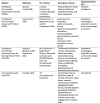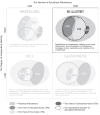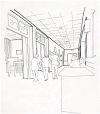Proposing a multi-method phenomenological approach in exploring the perceived daily life experiences of people with dementia in their dementia care environments and immediate outdoor settings
- PMID: 40230655
- PMCID: PMC11994584
- DOI: 10.3389/frdem.2025.1502911
Proposing a multi-method phenomenological approach in exploring the perceived daily life experiences of people with dementia in their dementia care environments and immediate outdoor settings
Abstract
The environment in this study is presented primarily drawing on the theoretical definition of home, and its experience and meaning to the individual with dementia, with an interest in access to outdoors. Notions of perception, cognitive image and affordance are central to the sense of home, and in turn the sense of self that this may inform and support. This theoretical framework informs the multi-method phenomenological approach proposed, through themes of spatial legibility, cultural appropriateness, fascination, user-centredness and personalisation. The novelty of the methodological toolkit lies in the incorporation of methods that have been traditionally used in research with people with dementia as the basis of the framework, but which are supplemented by additional layers developed from conventional architectural tools to create a more visual representation of the environmental experience. Despite its apparent complexity, the methodology yields a very clear and precise image of the person's presence in her surroundings, at once providing a location in space and time, her mood and engagement, as well as a layering of the affordances that may have informed her behavior. This method was developed as part of this research, and remains unique to it. Its innovation lies in the progression of the DCM tool, the integration of the notion of affordances and architectural mapping techniques to propose a holistic depiction of the care experience of people with dementia.
Keywords: architecture; dementia design; dementia outdoors; enabling environments; multi-methods.
Copyright © 2025 Mercieca, Scott, Ward Thompson and Wilkinson.
Conflict of interest statement
The authors declare that the research was conducted in the absence of any commercial or financial relationships that could be construed as a potential conflict of interest.
Figures















Similar articles
-
Home Triad: A New Exploration of Home for People Living With Dementia Based on Lefebvre's Spatial Triad.HERD. 2024 Jan;17(1):253-269. doi: 10.1177/19375867231195283. Epub 2023 Sep 4. HERD. 2024. PMID: 37667575
-
Supporting the spirituality of older people living with dementia in nursing care: A hermeneutic phenomenological inquiry into older people's and their family members' experiences.Int J Older People Nurs. 2023 Jan;18(1):e12514. doi: 10.1111/opn.12514. Epub 2022 Nov 15. Int J Older People Nurs. 2023. PMID: 36379909 Free PMC article.
-
Offering architects insights into experiences of living with dementia: A case study on orientation in space, time, and identity.Dementia (London). 2019 Feb;18(2):742-756. doi: 10.1177/1471301217692905. Epub 2017 Feb 7. Dementia (London). 2019. PMID: 28173720
-
Remotely delivered information, training and support for informal caregivers of people with dementia.Cochrane Database Syst Rev. 2021 Jan 4;1(1):CD006440. doi: 10.1002/14651858.CD006440.pub3. Cochrane Database Syst Rev. 2021. PMID: 33417236 Free PMC article.
-
Continuity and Change in Life Engagement Among People With Dementia.J Holist Nurs. 2015 Sep;33(3):205-27. doi: 10.1177/0898010114564684. Epub 2014 Dec 30. J Holist Nurs. 2015. PMID: 25549961 Review.
References
-
- Alexander C. (1977). A Pattern Language. Oxford: Oxford University Press.
-
- Alzheimer's Society (2022). What is Dementia? Symptoms, Causes and Treatment. Available online at: https://www.alzheimers.org.uk/about-dementia/types-dementia/what-is-deme... (accessed September 10, 2022).
-
- Ballantyne A. (2007). Deleuze and Guattari for Architects. London: Routledge. 10.4324/9780203934203 - DOI
-
- Ballantyne A. (2007). Deleuze & Guattari for Architects. London: Routledge.
-
- Barker R. (1968). Ecological Psychology: Concepts and Methods for Studying the Environment of Human Behaviour. Stanford, CA: Stanford University Press.
LinkOut - more resources
Full Text Sources

